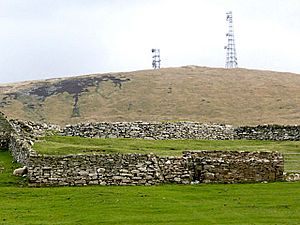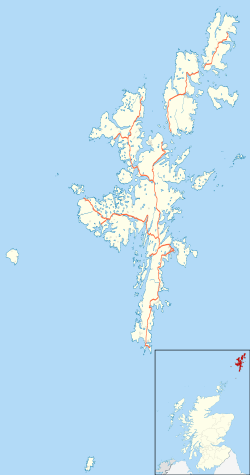Clumlie Broch facts for kids

Clumlie Broch, behind a field wall
|
|
| Location | Mainland, Shetland |
|---|---|
| Coordinates | 59°56′46″N 1°16′40″W / 59.946028°N 1.277694°W |
| Type | Broch |
| History | |
| Periods | Iron Age |
Clumlie Broch is an ancient stone tower from the British Iron Age. It is located on Mainland, Shetland, an island in Scotland. This type of building is called a broch. Brochs were built by people living in Scotland thousands of years ago.
Contents
Where is Clumlie Broch?
Clumlie Broch is found in a place called Dunrossness. This is on the southern part of Mainland, Shetland. It is about 8 kilometres north of Sumburgh Airport. The broch stands on a small hill in a flat, open field. An old farm, called a croft, was built very close to the broch ruins.
What does Clumlie Broch look like?
Clumlie Broch is a large circular building. It measures about 21 metres across from the outside edge. The inside space is about 8 metres wide. A stone wall, called a dyke, covers much of the western side. But you can still see the entrance passage. There is also a small room near the entrance called a guard cell. The walls of the broch still stand about 2 metres high today.
Discoveries at Clumlie Broch
Clumlie Broch was partly dug up by an archaeologist named Gilbert Goudie. This happened in 1887. He also helped to fix some of the old walls.
What was found during the dig?
Mr. Goudie found a stone box, called a cist, about 75 centimetres above the floor. He thought that after the broch was no longer used as a home, people might have used it for burials.
Many interesting items were found during the excavation. These included:
- Stone tools, which were used for different tasks.
- Quern stones, which were used to grind grain into flour.
- Whetstones, used to sharpen tools.
- Spindle whorls, which helped in making thread.
- Hammer stones, used for hitting or shaping things.
Archaeologists also found many pieces of pottery. There were also animal bones and shells. A small piece of a painted Roman bowl was also discovered. This shows that people living here might have traded with the Roman Empire.


